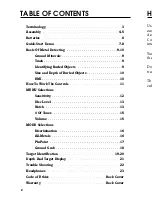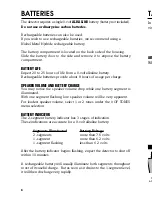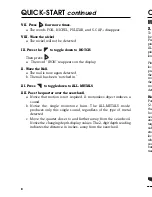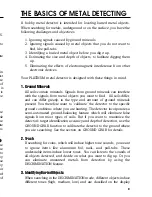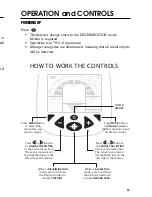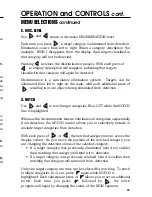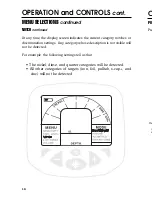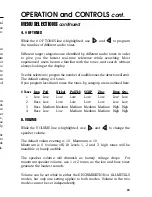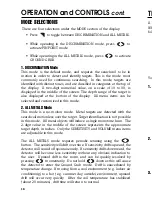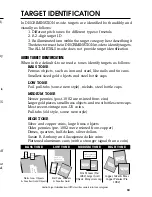
21
4
ASSEMBLY
Assembly is easy and requires no tools.
●
1
Loosen both Locking Collars by rotating 100%
counterclockwise
●
2
Insert the Upper Stem into the S-Rod and click
Silver Button into hole
●
3
Position the lower stem with the silver
button toward the back.
Using the bolt and knurled knob,
attach the search coil to the lower
stem.
●
4
Press the button on the upper end of
the lower stem, and slide the lower stem
into the upper stem.
Adjust the stem to a length that lets
you maintain a comfortable upright
posture, with your arm relaxed at
your side, and the search coil
parallel to the ground in front of you.
●
5
Wind the cable securely around the
stems.
●
6
Insert the plug into the matching
connector on the back of the detector
body. Be sure that the key-way and
pins line up correctly.
●
7
Tighten both locking collars.
●
8
Secure the cable with the 2 velcro straps
provided, one on the lower stem close to the
coil, one on the upper stem, close to the
housing.
Caution:
Do not force the plug in. Excess force will
cause damage.
To disconnect the cable, pull on the plug.
Do not pull on the cable.
Locking
Collar
Locking
Collar
Upper
Stem
Cable
Knurled
Knob
Bolt
Coil
S-Rod
Velcro
Strap
Velcro
Strap
READING THE DISPLAY
The Liquid Crystal Display (LCD) shows the PROBABLE
identification of the targeted metal, as well as the
PROBABLE depth of the target.
The detector will register a consistent target identification,
upon each sweep of the coil, when a buried target has
been located and identified. If, upon repeated passes over
the same spot, the target identification reads
inconsistently, the target is probably a trash item, or
oxidized metal. With practice, you will learn to unearth only
the repeatable signals.
The segment identifications are highly accurate, when
detecting the objects described on the label. However, if an
object registers in a given category for an unknown buried
object, you could be detecting a metallic object other than
the object described on the label, but with the same metallic
signature. Also, the greater the distance between the target
and the coil, the less accurate the target identification.
GOLD TARGETS
Gold objects will register on
the left side of the LCD scale.
Gold flakes
will register under iron.
Small gold items
will register under foil or 5¢.
Medium-sized gold items
will register
between nickel and or s-cap+.
Large gold items
will register under Zinc.
SILVER TARGETS:
Silver objects will register
to the right of the scale, under COINS.
IRON:
All sizes of iron objects will register on the far-
left side of the scale. This could indicate a worthless
item such as a nail, or a more valuable historic iron relic.
FOIL:
Aluminum foil, such as a gum wrapper, will
register as foil. A small broken piece of pull tab may also
register here.
NICKEL:
Most newer pull-tabs from beverage cans,
the type intended to stay attached to the can, will
register here. Many gold rings will also register here.
PT:
Older pull tabs, which always detached completely
from the can, register here. Many medium size gold ring
also register here.
ZINC:
Newer US pennies (post-1982), and Canadian
$1 and $2 coins register here. Many non-US coins of
recent vintage will also register here.
DIME:
Dimes and older copper pennies (pre-1982)
register here.
QTR+:
Silver Dollars, Half-Dollars and Quarters, very
large iron objects, like a sewer lid, will register here.
Caution:
The target indications are visual references.
Many other types of metal can fall under any one of
these categories. While the detector will eliminate or
indicate the presence of most common trash items, it is
impossible to accurately classify ALL buried objects.
3-SEGMENT DEPTH INDICATOR:
The Depth Indicator is accurate for coin-sized objects.
It indicates the depth of the target, in inches as
follows:
Segments Illuminated
Top
Segment
=
0 to 3” deep,
Top & Middle
Segment =
3” to 6” deep
All
Segments
=
Over 6” deep.
Large and irregularly-shaped objects will yield less
reliable depth readings
When passing over an object, the indicators will light
up and stay illuminated for three seconds. If the depth
indication varies with each sweep, try sweeping at
different angles; there may be more than one target
present. With practice, you will learn the difference
between accurate readings, multiple targets, and
highly erratic readings which evidence trash or
irregularly shaped objects.
DEPTH AND TARGET DISPLAY


